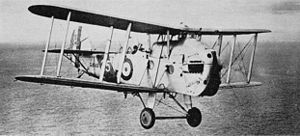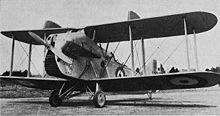Blackburn Blackburn Videos - Picture

|
|
Blackburn Blackburn
R.1 Blackburn

Picture - Blackburn Blackburn II
Role: Carrier-based reconnaissance
Manufacturer: Blackburn Aeroplane & Motor Company Limited
First flight: 1922
Introduced: 1923
Retired: 1931
Primary user: Fleet Air Arm
Number built: 44
Developed from: Blackburn T.2 Dart
The Blackburn R-1 Blackburn was a 1920s British single-engine fleet spotter/reconnaissance aircraft built by Blackburn Aircraft.
History
The Blackburn was developed to meet a naval requirement (Specification 3/21) for a carrier-based reconnaissance aircraft and gun spotting aircraft. Blackburn designed a new fuselage and used the wing and tail surfaces from the Blackburn Dart. The pilot sat in an open cockpit above the engine, a navigator sat inside the fuselage and a gun position was located at the rear of the fuselage cabin. The aircraft's two-bay wings could fold for stowage aboard aircraft carriers, with the upper wing attached directly to the fuselage, which filled the interplane gap. Armament was a single forward firing Vickers machine gun mounted externally to the left of the pilot, with a Lewis gun on a Scarff ring for the gunner.
Three prototypes were flown during 1922, leading to an initial production contract for 12 aircraft. The production aircraft were designated Blackburn I and the first deliveries to the Fleet Air Arm at Gosport began in April 1923. 18 more Blackburn Is were built in 1923-4. Its first operational deployment was with No. 422 Fleet Spotter Flight, which deployed aboard HMS Eagle in the Mediterranean in 1923.
A further order for 29 Blackburns was placed with the larger Napier Lion V engine and designated the Blackburn II. The upper wing was raised 22½ in (0.57 m) to improve handling. A few Blackburns were used as dual-control trainers and all the Blackburn Is were converted to II standard before the type became obsolete in 1931, when they were replaced by the Fairey IIIF.
Variants
Blackburn Prototype, three built. Blackburn I Production version with a 449 hp (335 kW) Napier Lion IIB engines, 33 built. Blackburn II Improved production version with a 464 hp (346 kW) Napier Lion V, and increased gap between wings. 29 built.

Picture - Blackburn Blackburn Trainer
Blackburn Trainer Trainer version of Blackburn I, fitted with side by side cockpit and dual controls. Known by the Fleet Air Arm as the Bull. Two out of Blackburn I batch.
Operators
United Kingdom
Royal Navy
Royal Air Force
Specifications (Blackburn I)
Data from British Naval Aircraft since 1912
General characteristics
Crew: 3
Length: 36 ft 2 in (11.02 m)
Wingspan: 45 ft 6 in (13.87 m)
Height: 12 ft 6 in (3.81 m)
Wing area: 650 ft² (60.40 m²)
Empty weight: 3,929 lb (1,786 kg)
Loaded weight: 5,962 lb (2,710 kg)
Max takeoff weight: 6,648 lb (3,022 kg)
Powerplant: 1x— Napier Lion 12-cylinder W-block inline engine, 450 hp (346 kW)
Performance
Maximum speed: 122 mph (157 km/h) at 3,000 ft
Service ceiling: 12,950 ft (3,950 m)
Rate of climb: 690 ft/min (210 m/min)
Endurance: 4.25 hours
Armament
Guns: 2 x— .303 in (7.7 mm) Lewis guns
Comparable aircraft
Avro Bison
Related lists
List of aircraft of the RAF
Bibliography
Jackson, A.J. (1968). Blackburn Aircraft since 1909. London: Putnam. ISBN 0 370 00053 6.
Thetford, Owen (1978). Aircraft of the Royal Navy since 1912 (Fourth ed.). London: Putnam. ISBN 0 370 30021 1.
The Illustrated Encyclopedia of Aircraft (Part Work 1982-1985). Orbis Publishing.
Blackburn Blackburn Pictures and Blackburn Blackburn for Sale.
Living Warbirds: The best warbirds DVD series.
Source: WikiPedia